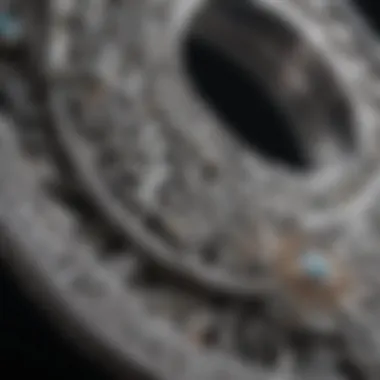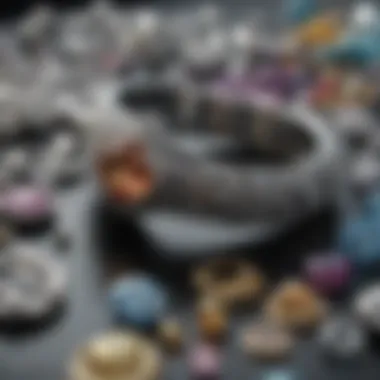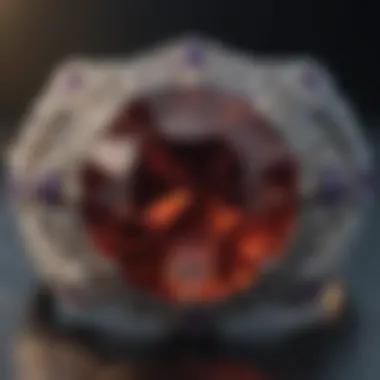Understanding Sterling Silver Components in Jewelry


Intro
Sterling silver remains a popular choice in jewelry making due to its unique properties and versatility. Understanding the intricacies of sterling silver and its components leads to better decision-making for both jewelry designers and enthusiasts. This article delves into the fundamentals of sterling silver, gemstone interactions, and the care considerations necessary for preserving these beautiful pieces.
By exploring how sterling silver interacts with various gemstones, readers gain insight into design choices, market trends, and the value of jewelry in both artistic and commercial contexts.
Gemstone Overview
Definition of Gemstones
Gemstones are naturally occurring minerals or rocks that, when cut and polished, are used in jewelry and ornamentation. They can vary widely in color, durability, and rarity. Common examples include diamonds, rubies, sapphires, and emeralds. Their appeal lies not just in their aesthetic beauty, but also in their perceived value and significance within various cultures.
Classification of Gemstones
There are two primary categories of gemstones: precious and semi-precious.
- Precious Gemstones: These include diamonds, sapphires, emeralds, and rubies. They are rare and typically command high prices.
- Semi-Precious Gemstones: This classification includes a wide array of stones such as amethyst, garnet, and turquoise. Although they are more abundant, many semi-precious stones hold significant value depending on color, clarity, and craftsmanship.
Each gemstone has its own unique properties and characteristics, influencing not only their market value but also their suitability for specific jewelry applications.
Historical Significance
Origins of Gemstone Use
The use of gemstones dates back thousands of years, with evidence found in various archaeological sites. Early humans likely utilized them for their beauty and perceived mystical properties. Over time, gemstones became symbols of power, wealth, and status.
Cultural Insights: Gemstones in Ancient Civilizations
Different cultures have attributed various meanings and significances to gemstones. For example, in ancient Egypt, turquoise was revered and often used in funerary decorations. In contrast, diamonds were regarded as a symbol of wealth and were associated with the divine in India. The uses of gemstones have evolved, yet their cultural significance remains strong, influencing modern jewelry design and the choices of gemstone enthusiasts today.
"The allure of gemstones is not merely found in their visual appeal but also in the rich tapestry of history and culture they embody."
By understanding these factors, jewelry makers and collectors can make well-informed decisions when selecting gemstones to pair with sterling silver, enhancing both the beauty and the value of their creations.
Prolusion to Sterling Silver
Sterling silver is a material of great significance in the realm of jewelry making. Understanding its components becomes essential for both creators and consumers. This section introduces sterling silver, defining its unique attributes and contextualizing its historical background. Knowledge of this metal's composition and characteristics allows for informed decisions when creating or purchasing pieces. Furthermore, it sets the foundation for the discerning collector and the jewelry designer alike, who must navigate the often intricate details of metal types and qualities.
Definition and Composition
Sterling silver is an alloy primarily composed of 92.5% silver and 7.5% other metals, typically copper. This combination enhances its hardness and durability while retaining the desirable qualities of silver. The term "sterling" originated from the British currency and has come to signify a specific degree of purity. Knowing the exact composition is crucial when considering the value and performance of sterling silver jewelry. The presence of non-silver metals can affect color and wear, making it essential for consumers to recognize what they are purchasing.
Historical Context
The history of sterling silver dates back hundreds of years. The British standardized the alloy in the 14th century to ensure consistent quality for coins and jewelry. Over time, artisans in Europe began refining techniques and creating exquisite pieces using this metal. Its popularity spread, becoming synonymous with quality and elegance in various cultures. Also, fluctuating silver prices have led to its lasting appeal as an alternative to more expensive metals like gold and platinum. Understanding this history enriches one’s appreciation of sterling silver and its ongoing significance in jewelry.
Sterling Silver vs. Other Silver Types
When comparing sterling silver to other silver variants, several distinctions arise. For instance, fine silver consists of 99.9% silver but lacks the strength needed for regular use. Argentium silver, an alloy developed in the 1970s, includes germanium for enhanced tarnish resistance. Each type has its own strengths and drawbacks, affecting jewelry design and usability.
- Sterling Silver: Durable, 92.5% silver, widely used in jewelry.
- Fine Silver: Softer, more malleable, 99.9% silver, better for specific applications.
- Argentium Silver: Contains germanium, increasing tarnish resistance, but can be more expensive.


Choosing between these metals will depend on the intended use, budget, and aesthetic preference. By understanding these differences, one can better appreciate the distinct qualities of sterling silver.
Characteristics of Sterling Silver Components
The characteristics of sterling silver components play a critical role in the value and functionality of jewelry items. Understanding these traits is fundamental for both creators and consumers. Recognizing the purity, color, and durability of sterling silver can influence design choices, user experience, and ultimately the market price of the items.
Purity Standards and Markings
Sterling silver is defined as an alloy consisting of 92.5% silver and 7.5% other metals, typically copper. This composition ensures strength while maintaining the aesthetic qualities that silver is known for. The purity of sterling silver is marked using specific stamps. Common marks include "925," indicating 92.5% silver content. It is important to check for these marks, especially when purchasing items, as it guarantees the authenticity and quality of the silver. The absence of such markings may signal a lower quality or even imitation metals, which do not hold the same value.
Color and Luster
The color and luster of sterling silver are distinguishing features that can affect its desirability. Freshly polished sterling silver displays a bright white color with a reflective quality. This shine can diminish over time due to tarnishing, which occurs when silver reacts with sulfur and oxygen in the air. Despite this natural oxidation process, the innate beauty of sterling silver can be restored with appropriate cleaning methods. Consumers often appreciate the luster, as it enhances the visual appeal of jewelry, especially when combined with gemstones. The color contrasts beautifully with various stones, creating striking combinations.
Durability and Workability
Durability is a crucial aspect of sterling silver components. While pure silver is too soft for regular wear, the addition of copper in sterling silver provides necessary strength. This enhanced durability allows artisans to create intricate designs without compromising the item’s structural integrity. Furthermore, sterling silver is relatively easy to work with, making it a favorite among jewelry makers. It can be soldered, cast, and shaped into different forms, which allows for creativity in design greatly appreciated by both makers and collectors.
The combination of durability and workability ensures that jewelry made from sterling silver can withstand daily wear while retaining their beauty over time.
Common Components of Sterling Silver Jewelry
In the realm of jewelry making, understanding the various components of sterling silver is crucial. Each part plays a significant role in both the functionality and the aesthetic appeal of the finished piece. By delving into the common components, we can better appreciate how they contribute to the overall integrity and design of sterling silver jewelry.
Clasps and Findings
Clasps and findings are essential for securing jewelry pieces. They ensure that necklaces and bracelets remain intact while being worn. The most common types include spring rings, lobster clasps, and magnetic clasps. Each type has its unique mechanism, offering varying levels of security and ease of use. For example, lobster clasps are widely favored for their robust hold, making them ideal for heavier pieces.
Moreover, findings can significantly impact the overall look of the jewelry. Using high-quality sterling silver findings adds a touch of sophistication and can enhance the durability of the piece. It is important to consider not only the functionality but also the visual harmony between these elements and the jewelry design itself.
Chains and Links
Chains and links form the foundation of many sterling silver jewelry designs. They are vital in constructing necklaces, bracelets, and anklets. The strength and style of the chain can dramatically influence the piece's appearance.
Popular styles include curb chains, cable chains, and box chains, each showcasing a different texture and weight. Choosing the right chain can elevate the piece, making it look either contemporary or vintage, depending on the design intentions. Furthermore, understanding the gauge or thickness of the links is essential for ensuring that the jewelry can support any added weight from pendants or charms without compromising structural integrity.
Settings for Gemstones
The setting is where the gemstones reside in sterling silver jewelry. It serves to hold the stones securely while enhancing their visual appeal. Different types of settings, such as prong, bezel, or pave, offer distinct styles and security levels for gemstones.
Prong settings, for instance, are popular for showcasing the brilliance of larger stones, whereas bezel settings offer protection and a sleek look. Selecting the right setting is critical, as it influences both the overall design and the durability of the piece. It is advisable for jewelers to harmonize the setting style with the type of gemstone used, ensuring that both elements complement each other beautifully.
Bracelets, Earrings, and Necklaces
Bracelets, earrings, and necklaces represent some of the most popular forms of jewelry made from sterling silver. Each type of jewelry presents unique opportunities for design and craftsmanship.
- Bracelets can range from simple chains to intricate bangles, and often feature various embellishments such as charms or engraved plates.
- Earrings might include studs, hoops, or dangles, providing an array of choices based on personal style and occasion.
- Necklaces can be custom-designed with pendants or layered effects, allowing for personalization.
The importance of these components lies not only in their individual construction but also in how they can be combined to tell a larger story through jewelry design. Maintaining a coherent design language across these different types can elevate the vision, making every piece feel intentional and thought-out.
Understanding each component's role in sterling silver jewelry allows for a more informed approach to design and craftsmanship.


By comprehensively examining these common components, we appreciate their significance in the overall composition of sterling silver jewelry. This, in turn, enriches our understanding of jewelry practices and the artistry inherent in creating appealing pieces.
Benefits of Using Sterling Silver in Jewelry Making
Sterling silver has earned its reputation in the jewelry industry due to its unique qualities. The choice of materials significantly impacts the final product, and understanding the benefits of sterling silver is vital. This section will dive into aesthetic appeal, affordability compared to gold and platinum, and compatibility with various gemstones. These elements make sterling silver a preferred choice among jewelry makers and enthusiasts alike.
Aesthetic Appeal
One of the primary reasons that sterling silver is desired in jewelry making is its aesthetic appeal. The metal achieves a soft, white luster that mimics the appearance of platinum, but with a distinct warmth. This brightness complements many styles, from modern to vintage, making it versatile. The shininess enhances the design elements, creating elegant pieces that catch the eye. Moreover, sterling silver can be easily shaped and molded. Craftspeople can create intricate designs that showcase artistic details, setting their work apart.
Key Points on Aesthetic Appeal:
- Versatility in Design: Can be used for diverse styles.
- Enhanced Brightness: Reflects light beautifully.
- Texture Application: Easy to manipulate for detailed finishes.
"The beauty of sterling silver lies in its timeless elegance and the way it enhances the gemstones it accompanies."
Affordability Compared to Gold and Platinum
Affordability makes sterling silver especially appealing to both jewelry designers and consumers. Compared to gold and platinum, sterling silver offers a significantly lower price point. This makes it accessible for more individuals. As a metal, sterling silver is less costly to source and process, allowing artisans to create beautiful pieces without breaking the bank.
Advantages of Affordability:
- Cost-Effective Options: Ideal for budget-conscious customers.
- Diverse Range of Products: Allows producers to create varied items at lower costs.
- Higher Profit Margins for Artisans: Can produce quality pieces without substantial investment.
Compatibility with Various Gemstones
Sterling silver is an excellent medium for various gemstones, providing a harmonious fit that enhances the overall aesthetic. Its neutral hue allows colored stones to stand out distinctly. For instance, vibrant turquoise or deep garnets exhibit their rich pigmentation beautifully against a sterling silver backdrop. The metal is also suitable for various settings, including prong and bezel settings, which can securely hold stones while showcasing them effectively.
Benefits of Compatibility:
- Enhances Gemstone Colors: Neutral base allows for full expression of color.
- Versatile Settings: Provides flexibility for various gemstone types.
- Durable Compound: Strong enough to hold stones securely even with daily wear.
In summary, understanding the benefits of using sterling silver not only involves appreciating its beauty but also recognizing its affordability and versatility with gemstones. These aspects make it a prime choice for jewelry makers, cater to a broader audience, and ultimately elevate the art of jewelry design.
Caring for Sterling Silver Jewelry and Components
Maintaining sterling silver jewelry is crucial for preserving its appearance and luster. Sterling silver components can tarnish over time, which detracts from their aesthetic appeal. Proper care and maintenance practices can significantly prolong the life of your jewelry. This section outlines essential practices for cleaning, storing, and preventing tarnish, ensuring that your pieces remain in excellent condition.
Cleaning Techniques
Cleaning sterling silver jewelry requires care to avoid scratching or damaging the surface. There are several methods for cleaning sterling silver:
- Soap and Water: A simple solution is to mix mild soap with lukewarm water. Use a soft cloth to gently wipe the surface, removing dirt and oils. Rinse with clean water and dry thoroughly with a soft towel.
- Silver Polishing Cloth: Specialized polishing cloths are useful for removing tarnish effectively. Rub the cloth over the jewelry without using too much pressure. This can restore shine and remove tarnished areas without abrasive agents.
- Baking Soda Paste: Create a paste with baking soda and water. Apply a small amount to the tarnished areas using a soft cloth, then rinse and dry. This method is effective for stubborn tarnish.
Always test cleaning methods on a small, inconspicuous area before proceeding. Each piece of jewelry may react differently.
Storage Recommendations
Proper storage is vital to prevent scratches and tarnishing. Here are some guidelines for storing your sterling silver jewelry effectively:
- Use Anti-Tarnish Pouches: When storing your jewelry, consider using anti-tarnish pouches. These can absorb moisture and help prevent tarnishing.
- Keep in a Dry Place: Store sterling silver in a dry environment. Humidity can accelerate tarnishing.
- Avoid Jewelry Boxes with Felt Linings: Felt can trap moisture. Instead, opt for a lined box designed for silver storage.
- Separate Pieces: Store each item separately to avoid scratches. Using soft cloth pouches for individual pieces is a good practice.


Preventing Tarnish
Although sterling silver components will naturally tarnish over time, certain preventive measures can slow the process:
- Regular Wear: Surprisingly, wearing your jewelry can help. Body oils and skin acids can create a protective layer that reduces tarnish.
- Avoid Exposing to Chemicals: Keep sterling silver away from household cleaners, chlorine, and even perfumes. Chemicals can accelerate the tarnishing process.
- Proper Handling: When putting on or taking off jewelry, do so gently to avoid scratches or damage that could lead to tarnishing.
By implementing these care practices, you can ensure the longevity and beauty of your sterling silver jewelry and components. Regular attention to cleaning and storage not only enhances their appearance but also protects your investment in quality jewelry.
Market Trends in Sterling Silver Jewelry
Market trends in sterling silver jewelry are critical for understanding the current landscape of the jewelry industry. These trends inform both buyers and makers about what is popular, what styles are emerging, and how the market is evolving. Being aware of these trends can influence purchasing decisions and design choices, ensuring they align with consumer preferences.
Emerging Styles
Emerging styles in sterling silver jewelry showcase the innovative approaches taken by designers. One notable trend is the blend of traditional craftsmanship with modern aesthetics. Many designers are incorporating geometric shapes and clean lines into their pieces, appealing to a more contemporary audience.
Another trend is the resurgence of personalized jewelry. Items like name necklaces and initial rings are increasingly sought after. This style allows for individuality, as people look for pieces that reflect their identity.
Engraving and embedding colored gemstones is also gaining traction. These techniques add a unique flair to sterling silver pieces, making them more visually interesting. Through these means, designers are pushing the boundaries of classic sterling silver into uncharted territories.
Investment Considerations
Investing in sterling silver jewelry can be a prudent choice, both for collectors and those seeking to diversify their portfolios. Historically, sterling silver has maintained value well across economic cycles. Unlike fashion items, which can quickly go out of style, sterling silver pieces often stand the test of time.
It is crucial for potential investors to assess each piece for its intrinsic value. Factors such as purity, craftsmanship, and designer reputation should influence the investment decision. Limited edition pieces or those made by renowned jewelers may appreciate significantly over time.
Investing in sterling silver also offers an opportunity to support artisans and small businesses. This enhances the value of the purchase, as many consumers now prefer to buy locally crafted, ethically made items.
Sustainability and Ethical Sourcing
Sustainability is at the forefront of market trends today, including in the realm of sterling silver jewelry. Many consumers prioritize ethically sourced materials. This awareness has pushed brands to adopt responsible sourcing practices that consider the environmental impact of mining and production.
Brands are increasingly transparent about their supply chains, using recycled metals in their jewelry. This approach reduces the need for new materials and lowers the overall environmental footprint. Some companies even provide full disclosures regarding their sourcing processes, appealing to eco-conscious consumers.
Furthermore, ethical labor practices are gaining importance. Ensuring that artisans are compensated fairly is a pivotal element of a sustainable supply chain. This not only enhances the integrity of the jewelry but also builds consumer trust.
"The shift toward sustainability and ethical sourcing is reshaping the jewelry industry, with consumers increasingly demanding transparency from brands."
In summary, staying abreast of market trends in sterling silver jewelry is imperative. From unique designs to investment potential and ethical considerations, these factors significantly influence buyer behavior and investment strategy. Making informed choices assures that both customers and jewelry designers thrive in a transforming market.
End
The conclusion of this article encapsulates the significant aspects of sterling silver components in jewelry. Understanding these elements not only enhances knowledge about the material itself, but also influences the decisions made by both jewelry designers and consumers.
Recap of Key Points
Sterling silver is more than just a metal; it is an amalgam of artistry and practicality. Key points from the article include:
- Definition and Composition: It consists of 92.5% silver and 7.5% other metals, often copper. This balance gives it strength and beauty.
- Characteristics: Purity standards and markings help in identifying genuine sterling silver. Its distinct luster and durability make it a preferred choice for many jewelry pieces.
- Common Components: Various parts such as clasps, chains, and settings utilize sterling silver due to its workability and aesthetic appeal.
- Benefits: Its affordability in comparison to gold and platinum does not compromise its quality or visual appeal.
- Care Tips: Proper cleaning, storage, and maintenance prevent tarnish and prolong the life of sterling silver pieces.
- Market Trends: Emerging styles and an increasing focus on sustainability reflect the evolving landscape of sterling silver jewelry.
The Future of Sterling Silver in Jewelry
Looking forward, sterling silver is poised to remain a vital player in the jewelry market. Designers are continually exploring innovative techniques to incorporate this versatile material. As sustainability and ethical sourcing gain importance, consumers may favor brands that prioritize these considerations.
Moreover, the integration of technology into jewelry-making, like 3D printing and advanced design software, allows for more intricate designs that can elevate sterling silver jewelry to new heights. Gemstone enthusiasts will likely continue to discover new ways to pair sterling silver with various precious and semi-precious stones, creating unique combinations that highlight the characteristics of both materials.
In summary, the future of sterling silver in jewelry seems promising. Its unique blend of characteristics, affordability, and adaptability positions it well in the ever-evolving market.



